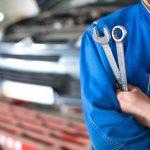The caliper housing is usually a one-piece construction of cast iron or aluminum. The brake caliper housing contains a cylinder bore. Machined into the cylinder bore is a groove to allow a square cut seal to be seated. At the top of the cylinder bore will be another groove that allows for a dust boot to be installed.
Find Your Online Car Repair Manual Today! ->>
This provides high pressure force through the brake pads to the disc brake rotor. The disc brake caliper piston is usually made of steel or aluminum but on some Chrysler models you can find a composite resin piston that looks very much like plastic.
Replacing brake calipers
Now this is just my personal opinion but I find that the factory does a much better job than a remanufacturing company overall. Whether you select a new or remanufactured unit is up to you and in both cases they usually have some type of warranty if there is a problem.
The term loaded refers to the fact that new brake pads are included and installed. Most also include new hardware such as caliper slides and anti rattle clips. Basically a loaded caliper is ready to bolt on and can take some of the human error possibilities out of the equation.
Problems replacing brake calipers
This allows for the free movement and more importantly a full release of the brake component. This small space is known as an air gap. Even though loaded replacement calipers are ready to go this air gap should be checked after the installation of these parts. If corrosion and rust has built up and the caliper does not move freely it can cause accelerated brake pad wear as described above.
On my you fix cars site I have a complete repair module that explains in detail about the different components of car disc brakes. For more articles posted recently on this website visit the online auto repair blog. Or this next link will take you back to the Disc brake diagnosis page from this post about how brake calipers work.









